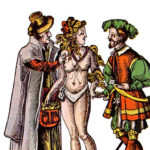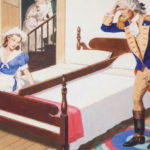The London Lock Hospital, which opened today in 1747, is known as the first VD clinic.
Lock was not a person’s name but a hold over from lock hospitals, also known at lazar hospitals, which housed those who suffered from leprosy. The first hospital for leprosy to use the Lock name, Southwark Lock Hospital, opened in the 12th century. The term “lock” doesn’t have a concrete definition. Some say it referred to the French word, la loque, for the rags or strips of linen used to cover afflicted areas of the leper’s body. Another possible origin is from an early Anglo-Saxon word, loc, that means “that by which anything is closed, an enclosed place, enclosure, fold.
Leprosy was on the decline by the 17th century, so there wasn’t much use for the lazar/lock hospital system anymore. Sexually transmitted infection was a much bigger problem. Several lazar hospitals, such the Southwark Lock Hospital and the Kingsland Lock Hospital, switched to treating syphilis and gonorrhea. Surgeon William Bromfeild (The correct spelling of his surname, not Bromfield) saw the need for a hospital in London dedicated to the treatment of venereal disease. He formed a committee and started work on The London Lock Hospital. They purchased a house near Hyde Park Corner to convert into the new hospital.
London Lock Hospital opened on January 31st with 30 beds, a staff of surgeons, physicians, nurses, apothecaries, a chaplain, and Bromfeild as a staff surgeon. The hospital treated 300 people in the first year. Unfortunately, the treatment of sexually transmitted infections used by the hospital was ineffectual. Mercury in a variety of forms was the most common treatment. It never worked and came with horrible side effects like tooth loss, increased sweating and salivation, bone loss, gum ulcers, and neurological damage. Mercury was more likely to kill you than cure you.
The National Health Service took over the London Lock Hospital in 1948, then closed it in 1952.
Last modified: January 31, 2017




